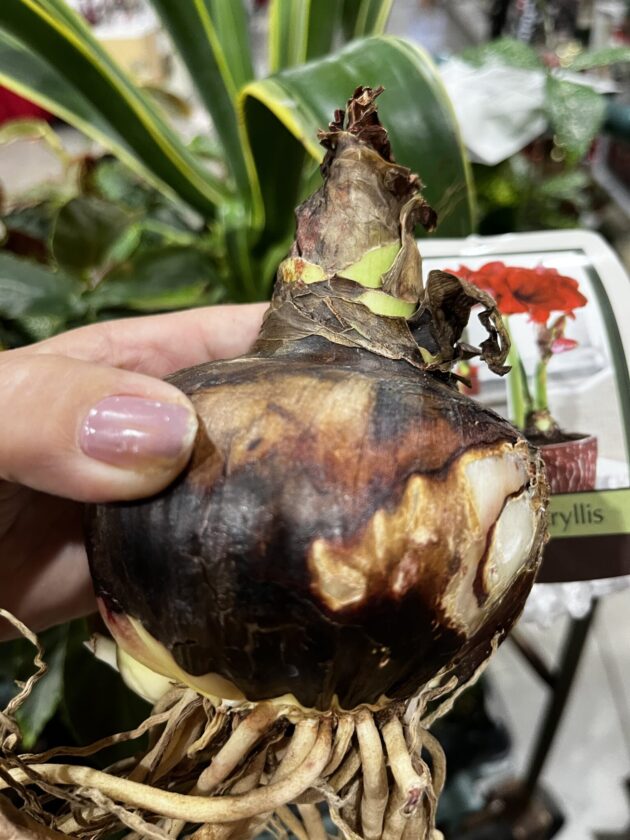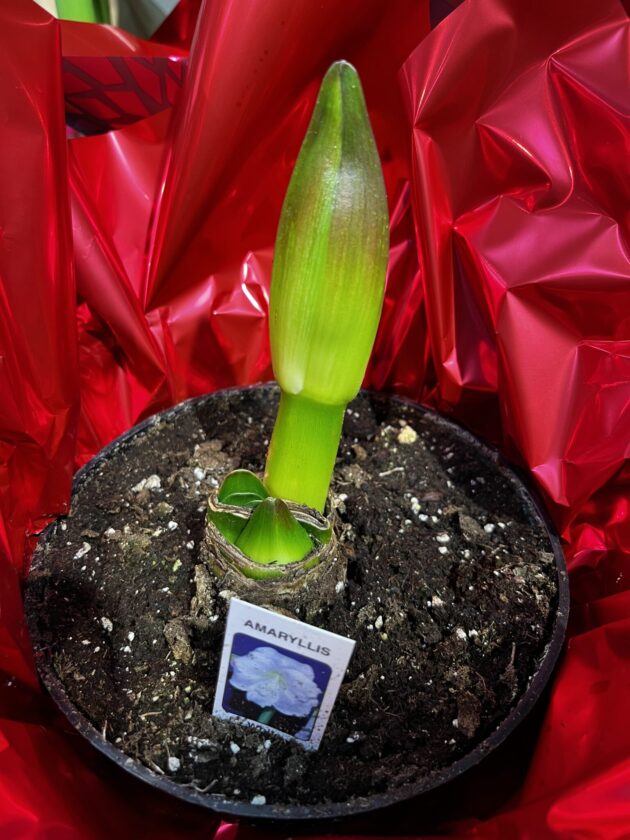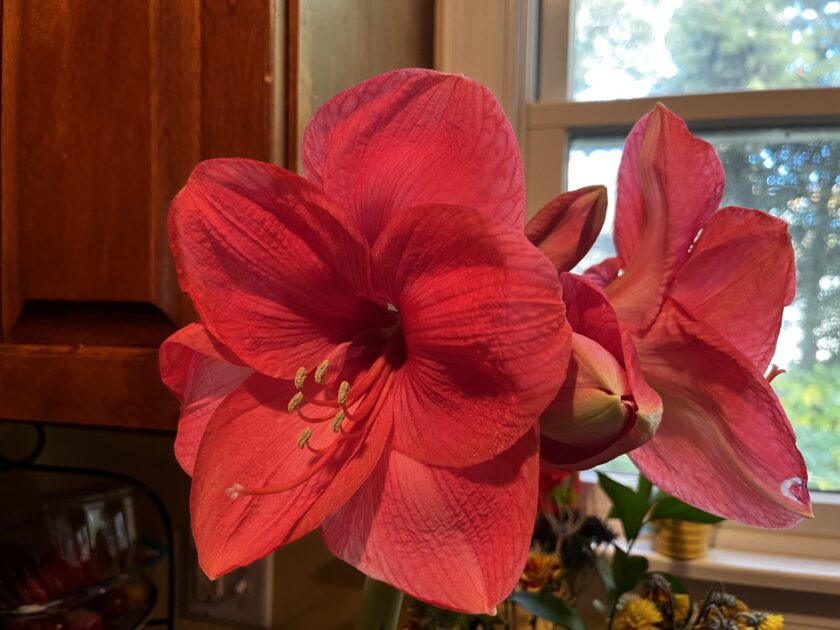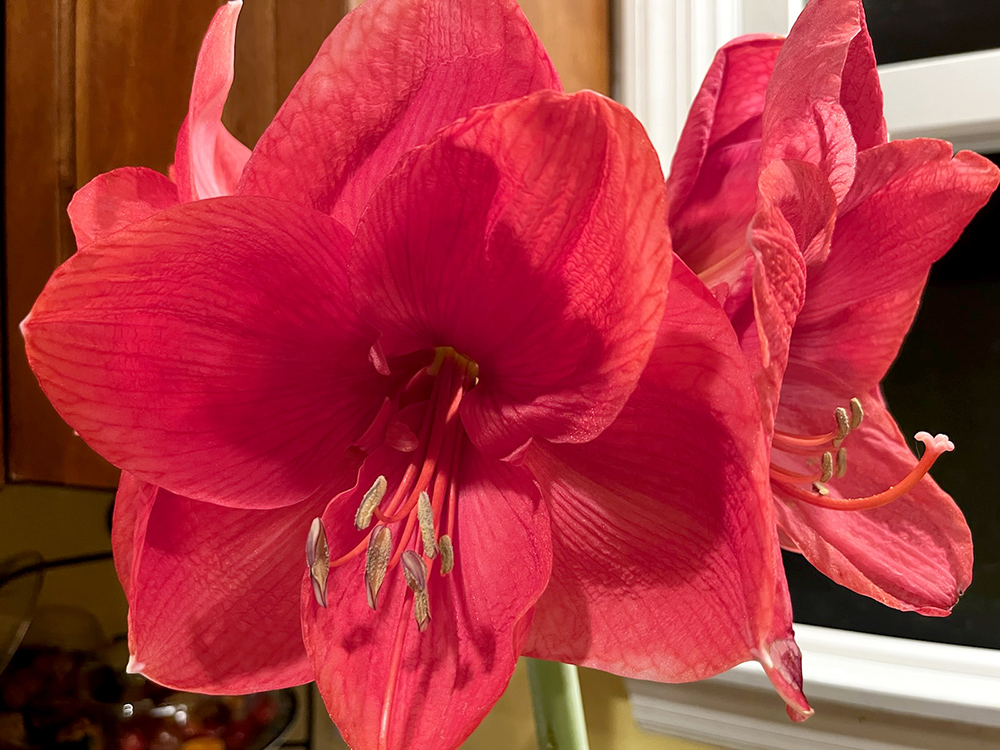Let It Grow
By Tammy Thornton
After a week of temperatures in the 70s, it’s hard to believe that it will soon be time for carving a turkey, lighting candles, and putting up a tree. But time doesn’t stand still. Soon you will want to deck the halls, and some of your decor will require a little pre-planning. If you have ever seen the stunning flowers of amaryllis blooming, you will want to make sure these beautiful flowers have been planted in time for the holidays.

Amaryllis flowers provide a stunning and vibrant burst of color during the dark days of winter, just when we need it most. Coming in rich colors with red, candy cane stripes, pinks, or pure white, amaryllis will make a statement in any room you grow them. Fortunately, these bold, beautiful flowers are super easy to grow. When it comes to purchasing an amaryllis, you will find them available in a few ways: a single unplanted bulb, an amaryllis kit, or a planted bulb just at the peak of blooming. If you buy an amaryllis kit, you will probably receive a container, some type of growing medium, and the bulb ready for planting. If you are purchasing the bulbs by themselves and are able to examine them out of the container, be sure to choose large firm bulbs. Larger bulbs will mean larger flowers and, most likely, more flowers on each stem. Make sure the bulbs are firm, since bulbs that are soft or squishy will be a sign of rot.

If you purchase an amaryllis kit or single, bare-root bulbs, you will want to plant several weeks before you plan to enjoy the flowers. For blooms in December, you should consider starting the growing process now. Don’t be nervous, because they are one of the easiest, most rewarding houseplants you will grow. If your bulb did not come with a container, choose one that is only slightly larger than the bulb (allow about an inch or two space around the bulb). Make sure it is also a fairly heavy pot or container, because once these large, tall flowers begin to bloom, they will be top-heavy and a lightweight container will fall over. Making sure your container has drainage holes is a key factor, because amaryllis do not like to sit in water. Without proper drainage, the bulb will rot and die. Add an inch or two of potting soil or a soilless mix, and plant the bulb, leaving about a third of the bulb above the soil. Water well, but make sure the water fully drains from the container afterwards. Place in a sunny area and you will soon see the stem shooting up, with a large flower bud on top. Though the sun will help your amaryllis bloom, keep it out of direct sunlight and make sure the location in your house isn’t too hot so that the blooms last longer. Eventually, you will see 2 – 4 blooms per stem. You may get lucky and see a second stem following the first. This stem will produce a second flush of flowers as the first group fades.

For the procrastinator, purchase amaryllis bulbs that have already been planted with the large bud showing. These make great gifts and will bloom fairly quickly after the initial watering. These plants have been groomed by the growers to bloom soon after purchasing. Water the plant well and within a week, you should see the flower stem and bud begin shooting up. At this point, your only job is to sit back and be amazed at your beautiful flower. Each day, the amaryllis will seem to grow and change. Do not water again until the top two inches of the soil have dried out. If the plant leans in a certain direction towards the sun, you should turn it so it grows evenly. Top-heavy plants may need a support for the stems, tied loosely with twine or decorative ribbon. One word of caution: keep your amaryllis away from pets, since the ASPCA lists them as toxic to dogs and cats.
Though many people treat amaryllis like annuals and throw them out after the holidays, you can save your plant to rebloom the following year. Some amaryllis have been known to last for decades. To care for your amaryllis after it has finished blooming, cut the spent flowers off so they do not start forming seeds, as this will take away from the energy of the bulb. At this point, the amaryllis plant may start forming leaves that were not present during the blooming process. Do not cut off the leaves or stems, since they will be the means to give energy back to the bulb for the next time it blooms. Place the plant in a sunny area. Once the stem starts to yellow and die, then you should cut it off, since its work is done. At this point, treat the amaryllis as a houseplant, watering it sparingly. You should keep the leaves on the plant, but cut off any that yellow and wilt. When all threat of frost is over in the spring, you can give your amaryllis a vacation in the garden. Take the pot and plant outside and allow it to bask in a partially sunny area. This will give it the extra boost to bloom the next season. You should also fertilize monthly. You can leave it out all summer, but keep it out of harsh afternoon sunlight.
In mid-September or mid-October, bring your amaryllis plant indoors. You will then cut off any remaining leaves and stem, remove the bulb from the soil, and keep it in a dry, dark area (like a basement or garage). Do not water. This process will send the bulb into dormancy, allowing you to “force” the amaryllis to bloom again for the holidays. Begin this process about 10 – 14 weeks before you want your amaryllis to bloom. They need to rest or stay dormant for about 6 – 8 weeks. Count back about 4 – 6 weeks from your goal bloom-time. This is when you want to start the planting process all over again. Plant the bulbs, water, fertilize, and bring them into a sunny location. Flowers should begin to develop in 4 – 6 weeks, although some bulbs may show signs of life sooner.
Once you see the beauty of an amaryllis and see how easy it is to grow, you will be smitten. Buy yourself some extras for after the holidays to brighten up the winter blues in January and February. Plant several a few weeks apart for continuous blooms or plant them all together for an elegant and dramatic display.
We would love to hear from our readers. Have you tried to grow amaryllis flowers? Send us your pictures, comments, and questions, to shorelocalgardener@gmail.com.
Tammy Thornton is a mom of four, a substitute teacher, and a Sunday school teacher. She is passionate about gardening and cooking, and loves the beach.









